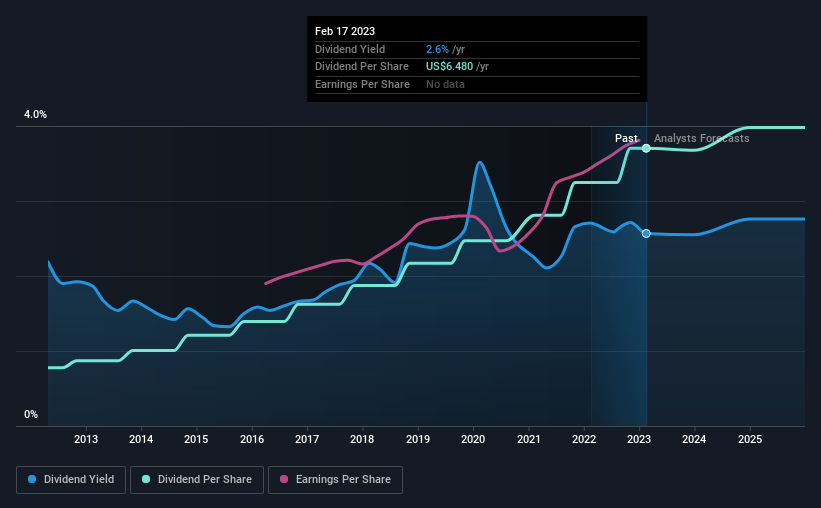Why You Might Be Interested In Snap-on Incorporated (NYSE:SNA) For Its Upcoming Dividend
Snap-on Incorporated (NYSE:SNA) stock is about to trade ex-dividend in four days. Typically, the ex-dividend date is one business day before the record date which is the date on which a company determines the shareholders eligible to receive a dividend. The ex-dividend date is an important date to be aware of as any purchase of the stock made on or after this date might mean a late settlement that doesn't show on the record date. In other words, investors can purchase Snap-on's shares before the 22nd of February in order to be eligible for the dividend, which will be paid on the 10th of March.
The company's upcoming dividend is US$1.62 a share, following on from the last 12 months, when the company distributed a total of US$6.48 per share to shareholders. Based on the last year's worth of payments, Snap-on has a trailing yield of 2.6% on the current stock price of $252.45. Dividends are an important source of income to many shareholders, but the health of the business is crucial to maintaining those dividends. We need to see whether the dividend is covered by earnings and if it's growing.
Check out our latest analysis for Snap-on
Dividends are typically paid out of company income, so if a company pays out more than it earned, its dividend is usually at a higher risk of being cut. Fortunately Snap-on's payout ratio is modest, at just 34% of profit. A useful secondary check can be to evaluate whether Snap-on generated enough free cash flow to afford its dividend. It paid out more than half (53%) of its free cash flow in the past year, which is within an average range for most companies.
It's positive to see that Snap-on's dividend is covered by both profits and cash flow, since this is generally a sign that the dividend is sustainable, and a lower payout ratio usually suggests a greater margin of safety before the dividend gets cut.
Click here to see the company's payout ratio, plus analyst estimates of its future dividends.
Have Earnings And Dividends Been Growing?
Stocks in companies that generate sustainable earnings growth often make the best dividend prospects, as it is easier to lift the dividend when earnings are rising. Investors love dividends, so if earnings fall and the dividend is reduced, expect a stock to be sold off heavily at the same time. For this reason, we're glad to see Snap-on's earnings per share have risen 12% per annum over the last five years. Snap-on is paying out a bit over half its earnings, which suggests the company is striking a balance between reinvesting in growth, and paying dividends. This is a reasonable combination that could hint at some further dividend increases in the future.
Another key way to measure a company's dividend prospects is by measuring its historical rate of dividend growth. Since the start of our data, 10 years ago, Snap-on has lifted its dividend by approximately 17% a year on average. It's exciting to see that both earnings and dividends per share have grown rapidly over the past few years.
To Sum It Up
Has Snap-on got what it takes to maintain its dividend payments? Earnings per share have grown at a nice rate in recent times and over the last year, Snap-on paid out less than half its earnings and a bit over half its free cash flow. Overall we think this is an attractive combination and worthy of further research.
While it's tempting to invest in Snap-on for the dividends alone, you should always be mindful of the risks involved. Case in point: We've spotted 1 warning sign for Snap-on you should be aware of.
A common investing mistake is buying the first interesting stock you see. Here you can find a full list of high-yield dividend stocks.
Have feedback on this article? Concerned about the content? Get in touch with us directly. Alternatively, email editorial-team (at) simplywallst.com.
This article by Simply Wall St is general in nature. We provide commentary based on historical data and analyst forecasts only using an unbiased methodology and our articles are not intended to be financial advice. It does not constitute a recommendation to buy or sell any stock, and does not take account of your objectives, or your financial situation. We aim to bring you long-term focused analysis driven by fundamental data. Note that our analysis may not factor in the latest price-sensitive company announcements or qualitative material. Simply Wall St has no position in any stocks mentioned.
Join A Paid User Research Session
You’ll receive a US$30 Amazon Gift card for 1 hour of your time while helping us build better investing tools for the individual investors like yourself. Sign up here

 Yahoo Finance
Yahoo Finance 
